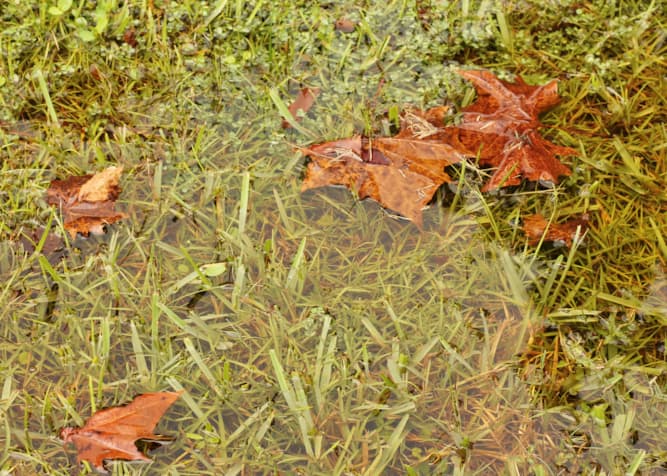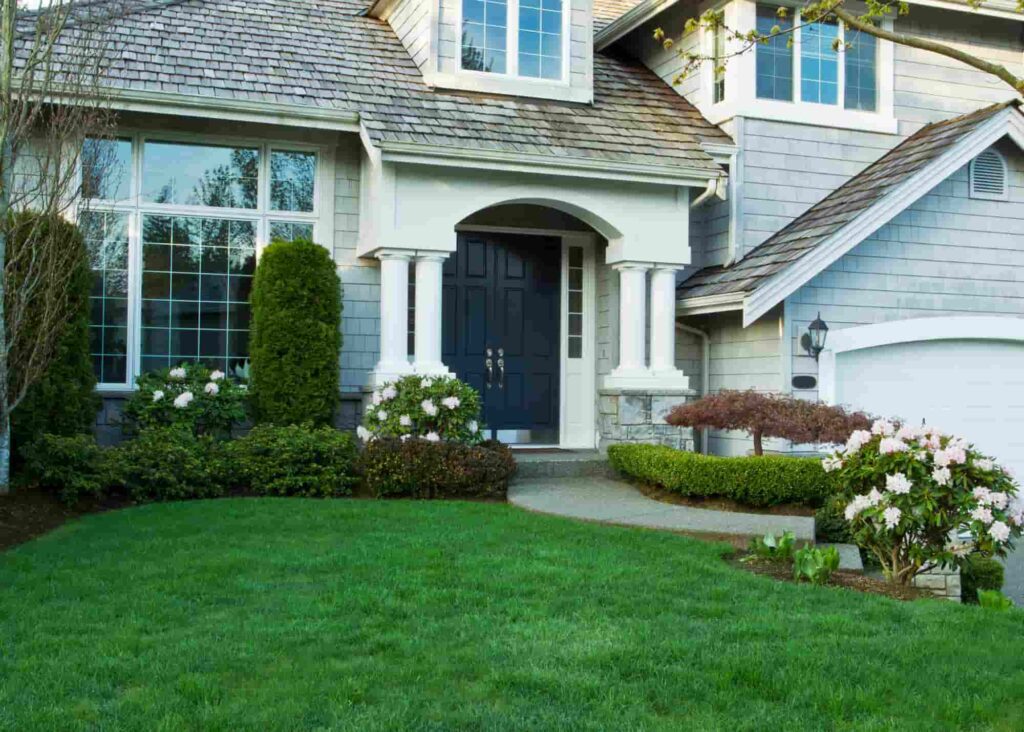If you’re a homeowner, your property is one of your greatest investments. You probably purchased your home to build memories with your loved ones and to create the sanctuary of your dreams.
When signs of drainage problems arise, you may wonder how you can prevent costly repairs and keep your home pristine and safe. Drainage issues around the house can rear their ugly, headache-inducing heads in a variety of ways.
By understanding how to identify these issues, you might be able avoid irreparable damage or necessary repairs that break your bank account. Similarly, the right landscaping professionals can provide customized solutions to the first signs of drainage problems, and the knowledge needed to prevent signs of poor drainage soil.
Table of Contents
What causes poor drainage?
Poor yard drainage can be caused by a variety of issues on your property. If you don’t have a great yard drainage system in place, or lack landscaping features, you may find yourself with a swampy, problematic yard.
Some of the main causes of poor drainage include:
-
- Ineffective Yard Drainage:
If you don’t have a yard drain system in place in your yard, or your drainage system needs to be repaired or replaced, your property might be plagued with signs of drainage problems, including frequent flooding and water damage issues.
-
- Improper Grading:
“Grading” means that slopes have been added to your yard to direct water away from your home and any other structures. If your yard doesn’t have grading, or has been improperly graded, signs of drainage problems, like pooling water or flooding, will arise.
-
- High Water Tables:
The water table in your yard is the underground level where your soil is saturated with water. As that table rises closer to the surface, surging groundwater can cause flooding and swamp-like conditions might become a frequent occurrence.
High water tables can cause the foundation of your home to shift and may cause other structural problems and drainage issues.
-
- Gutter or Downspout Issues:
Your gutters and downspouts are key components of an effective drainage system. You should clean your downspouts and gutters regularly, as debris, dirt, and leaves can accumulate and cause blockage which can lead to costly exterior and interior property issues.

Signs of poor drainage
The signs of poor drainage might not always be obvious until an extreme weather event (like a heavy rainstorm or a blizzard) occurs. However, there are many signs that you should be aware of, so that you can replace or repair your drainage system as needed.
Professional drainage specialists can help you to assess your property and provide customized solutions to correct any issues.
Some of the most common signs of poor drainage include:
-
- Basement mildew or water stains
- Black mold
- Clogged gutters or downspouts
- Debris
- Dead grass
- Flooded basements
- Flooded yard
- Insect infestation
- Mildew
- Oversaturation
- Soil erosion
- Standing water
- Structural cracks
- Swampy conditions
- Uneven foundation
- Warped floorboards
Expenses due to poor drainage
Neglected yard drainage can also lead to costly issues. Once you understand the signs of poor drainage, it’s easier to take preventative measures to remain within budget and prevent irreparable water damage. Statistics you should know about water damage to homes include:
-
- Annually, 1 in 60 insured homes has a water damage claim
- 98% of basements in the U.S. experience water damage
- 1 trillion gallons of water are wasted yearly through leaky faucets, pipes, and sprinklers
- Almost 30% of all yearly insurance claims are due to water damage
- $1,332 – $5,994: Average out-of-pocket homeowner’s cost for water damage repairs
Poor drainage can decrease your property value and worse, may cause hazardous conditions and health risks.
Some of the costly expenses you might incur as a result of poor drainage include:
-
- Clogged, frozen, or broken pipe repair
- Drainage system installation
- Drywall replacement due to black mold
- Floorboard repair or replacement
- Foundation repairs
- Gutter replacement
- Hardscape and walkway replacement
- Landscape repairs and replacement
- Lawn replacement

Soil issues caused by poor drainage
Signs of poor drainage also often become apparent in your yard’s soil. If your yard is swampy after a weather event, or if standing water remains in specific areas through dry weather, you may have poor drainage soil.
When your yard experiences the following issues, you may want to consult yard drainage specialists to ensure poor drainage soil doesn’t grow into a major headache:
-
- Dead Grass:
When you don’t have an effective drainage system in place, poor drainage soil can’t effectively absorb water. Thus, nutrients and needed hydration cannot make it to grass roots. This can result in patches or larger areas of dead grass in your yard.
-
- Compacted Soil:
You want a yard that your whole family can enjoy. However, over time, constant heavy foot traffic can cause your soil to become compacted. Similarly, heavy equipment can transform healthy topsoil into compacted soil.
Heavy weight pushes the soil, restricts roots and reduces absorption, creates hardened topsoil, and makes soil less porous. Soil health is vital to solving drainage issues around your house. When your soil is compacted or eroded, it will harden and won’t support grass or other plant life.
Compacted soil can lead to signs of poor drainage as it won’t absorb or divert excess water, and cannot filter water to the areas of your yard that desperately need it.
-
- Eroded Soil:
Poor drainage quickly erodes your soil and the signs are apparent on your property. Eroded topsoil can cause tree and plant roots to be exposed, cracks in your soil, sediment buildup on your walkways and hardscapes, a vast change in your landscape’s appearance, and more.
-
- Musty Odors:
Musty odors due to poor drainage can overwhelm both your yard and your basement. If a strong musty odor persists in your yard, you may have poor drainage soil.
-
- Standing Water or Swampy Yard:
The most glaring signs of poor drainage are areas of standing water or swamp-like, insect-infested areas in your yard. If your yard remains damp and swampy long after a weather event, you probably have poor drainage soil.
How you can tell if your drain tile is clogged
Drainage issues around the house can also lead to exterior and interior drain tile problems. If your drain tile is clogged, multiple issues might arise, including the following:
-
- Bad odors:
A clogged drain tile will cause rancid odors to emit from your drain, including sewage smells, rotten food scents, and musty odors.
-
- Gurgling noises:
Trapped air bubbles can cause your drain to make gurgling noises, which signifies clogged drain tiles and pipes.
-
- Sump pump overflow:
An overflowing sump pump could be the result of a clogged drain tile.
How to improve your yard drainage
Although there are labor-intensive DIY drainage solutions, when you see signs of poor drainage arise, it’s a good idea to consult a full-service landscaping team in your area. Hiring professionals can save you significant time and long-term costs, and optimize your yard drainage solutions for years to come.
Three of the most popular yard drainage solutions are French drains, retaining walls, and yard grading. Let’s take a look at the benefits of each.
French Drains
French drains are cost-effective, low-maintenance yard drainage systems that require little to no maintenance or repair for at least a decade. French drain installation experts in your area can quickly install this system, which runs underground through perforated pipes. The French drain diverts excess water and groundwater to the areas of your yard that need it the most.
Retaining Walls
Retaining walls greatly improve your yard drainage and enhance your landscape. A retaining wall can be built with stones, concrete, or aesthetic rocks and improves drainage by protecting soil from erosion and directing excess water.
Yard Grading
The right landscaping team can regrade your yard to ensure subtle, natural-looking slopes that prevent water pools from collecting near your home’s foundation. Grading reduces the swampy effects of poor drainage and manages the flow of water throughout your yard.
Based in Naperville, Illinois, family-owned and operated Ware Landscaping is dedicated to helping our Chicago area neighbors create the yards of their dreams. For over twenty years, we’ve been committed to enhancing landscapes and optimizing yard drainage on residential and commercial properties alike. If your property has signs of drainage problems, we can help.
Connect with us for all of your landscaping needs, and check out our website to discover our comprehensive services.











